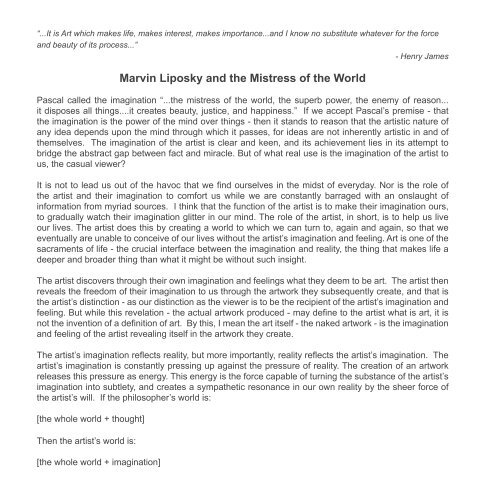MARVIN LIPOFSKY - Micaela
MARVIN LIPOFSKY - Micaela
MARVIN LIPOFSKY - Micaela
Create successful ePaper yourself
Turn your PDF publications into a flip-book with our unique Google optimized e-Paper software.
“...It is Art which makes life, makes interest, makes importance...and I know no substitute whatever for the force<br />
and beauty of its process...”<br />
- Henry James<br />
Marvin Liposky and the Mistress of the World<br />
Pascal called the imagination “...the mistress of the world, the superb power, the enemy of reason...<br />
it disposes all things....it creates beauty, justice, and happiness.” If we accept Pascal’s premise - that<br />
the imagination is the power of the mind over things - then it stands to reason that the artistic nature of<br />
any idea depends upon the mind through which it passes, for ideas are not inherently artistic in and of<br />
themselves. The imagination of the artist is clear and keen, and its achievement lies in its attempt to<br />
bridge the abstract gap between fact and miracle. But of what real use is the imagination of the artist to<br />
us, the casual viewer?<br />
It is not to lead us out of the havoc that we find ourselves in the midst of everyday. Nor is the role of<br />
the artist and their imagination to comfort us while we are constantly barraged with an onslaught of<br />
information from myriad sources. I think that the function of the artist is to make their imagination ours,<br />
to gradually watch their imagination glitter in our mind. The role of the artist, in short, is to help us live<br />
our lives. The artist does this by creating a world to which we can turn to, again and again, so that we<br />
eventually are unable to conceive of our lives without the artist’s imagination and feeling. Art is one of the<br />
sacraments of life - the crucial interface between the imagination and reality, the thing that makes life a<br />
deeper and broader thing than what it might be without such insight.<br />
The artist discovers through their own imagination and feelings what they deem to be art. The artist then<br />
reveals the freedom of their imagination to us through the artwork they subsequently create, and that is<br />
the artist’s distinction - as our distinction as the viewer is to be the recipient of the artist’s imagination and<br />
feeling. But while this revelation - the actual artwork produced - may define to the artist what is art, it is<br />
not the invention of a definition of art. By this, I mean the art itself - the naked artwork - is the imagination<br />
and feeling of the artist revealing itself in the artwork they create.<br />
The artist’s imagination reflects reality, but more importantly, reality reflects the artist’s imagination. The<br />
artist’s imagination is constantly pressing up against the pressure of reality. The creation of an artwork<br />
releases this pressure as energy. This energy is the force capable of turning the substance of the artist’s<br />
imagination into subtlety, and creates a sympathetic resonance in our own reality by the sheer force of<br />
the artist’s will. If the philosopher’s world is:<br />
[the whole world + thought]<br />
Then the artist’s world is:<br />
[the whole world + imagination]


